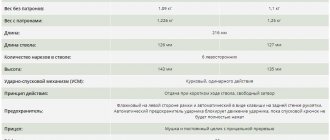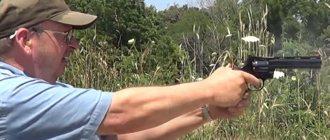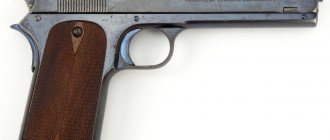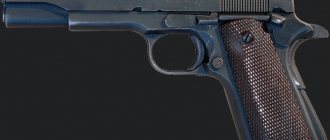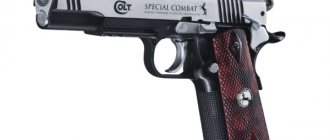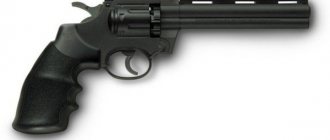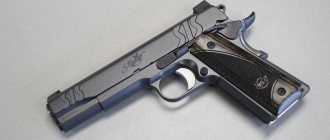| Colt Anaconda | |
| |
| Type: | Revolver |
| A country: | |
| Production history | |
| Manufacturer: | Colt's Manufacturing Company |
| Years of production: | 1990–1999 |
| Characteristics | |
| Weight, kg: |
|
| Length, mm: |
|
| Barrel length, mm: |
|
| Cartridge: |
|
| Caliber, mm: |
|
| Work principles: | Double action |
| Type of ammunition: | 6-shot drum |
| Aim: | Open, adjustable |
| Images on Wikimedia Commons: | Colt Anaconda |
Colt AnacondaColt Anaconda The Colt Anaconda
is a large-caliber revolver with a double-action trigger mechanism, produced from 1990 to 1999 by Colt's Manufacturing Company. The Anaconda is similar to the Colt Cobra, but has a reinforced frame and cylinder to accommodate more powerful cartridges such as the .44 Magnum and .45 Colt. Due to its heavy weight, the use of the Colt Anaconda as a service weapon was considered inappropriate; The revolver is mainly used for hunting and sport[1].
Development
Built on a reinforced frame, the Colt Anaconda was designed to compete with existing .44 Magnum models such as the Smith & Wesson Model 29, Ruger Redhawk, Ruger Blackhawk, and Dan Wesson Firearms revolvers. en]. Considering that many of these models had been on the market for 35 years, the Colt Anaconda's arrival in the big-bore pistol market was overdue.[2] Unlike most other pistols developed in the 1980s and 1990s, the Anaconda was never made of blued high-carbon steel—only stainless. The first models had poor accuracy, but after the barrel was modified, the Anaconda began to be considered one of the most accurate .44 Magnum revolvers[2][3]. The Colt Anaconda is intended primarily for shooting sports enthusiasts and hunters, as it is too large for law enforcement and complex for concealed carry.[1] Colt officially ceased production of the Colt Anaconda and many other double-action revolvers in October 1999, but some models were available to order until 2001.[1]
Development
Built on a new and heavier 'MM' frame, the Anaconda was brought out to compete with .44 Magnum contemporaries such as the Smith & Wesson Model 29, the Sturm, Ruger & Co. Redhawk and Blackhawk, and the Dan Wesson Firearms Model 44. Considering that many of these models had been marketed and sold for fully 35 years upon its introduction, the Anaconda was a very late entry into the large-bore handgun market. Unlike most other pistols introduced in the 1980s and 1990s, the Anaconda was never offered with a carbon steel blued finish, but was available only in stainless steel. When originally introduced Anacondas were plagued with poor accuracy, but changes to the barrels quickly corrected the problems to the point that Colt billed its new pistol as among the most accurate .44 Magnum revolvers in production. Anaconda revolvers were primarily marketed for sport enthusiast shooters and hunters, as they are too large for law enforcement general duty use or concealed-carry, although made-to-order limited production versions of the gun continued to be available from the Colt custom gun shop until approximately 2003.
Description
The Colt Anaconda was originally chambered in .44 Magnum, but in 1993 it was also offered in .45 Colt. Its design and finish are reminiscent of the Colt King Cobra, and the ventilated barrel is reminiscent of the Colt Python revolver.[2] The revolvers had a four-, six-, or eight-inch barrel. The handle was made of neoprene with corrugation. Large trigger and trigger mechanism (trigger mechanism). The sights are open with a red front sight insert and a fully adjustable white rear sight[2][3]. Some models were supplied from the factory prepared for the installation of an optical sight. To reduce recoil, some models were also equipped with a muzzle brake[3]. The trigger of these models is of the highest quality. The heavy, durable design also helps absorb recoil, reducing stress and allowing for relatively easy shooting.[2][3]
Features
Originally chambered for the .44 Magnum cartridge, in 1993 the Anaconda began to be offered in .45 Colt cartridge as well. Its fit and finish resembled an upsized King Cobra married to a ventilated-rib barrel reminiscent of the Python's. Initially marketed with a satin brushed stainless finish, a highly polished mirror-like option known as “Ultimate Stainless” was cataloged for a time through the Colt Custom Shop. Anacondas came equipped with four, six, or eight inch barrels, neoprene synthetic rubber finger-grooved combat-style grips with nickel colored 'Rampant Colt' medallions, large target type hammers and triggers, as well as with a front and fully white outline rear . Some models were factory drilled and tapped for telescopic sight mounting, while others were shipped with recoil reducing Mag-na-ported barrels. The trigger actions on these guns are rated as very high-quality, and the heavy-duty solid construction and weight tends to absorb recoil, making the Anaconda relatively easy to shoot with heavy loads.
Kodiak
Introduced in 1993, the Kodiak was similar to the Anaconda in that it was constructed entirely of stainless steel, but offered the additional features of a recoil-reducing factory magna-ported barrel and unfluted cylinder.
There were 2000 Kodiaks made as a special run of Anacondas, breaking away from their long history of naming revolvers after snakes. A special run of 1000 King Cobras was made about the same time, having the same Magna-Ported barrel and unfluted cylinder and were called the Grizzly. There was an uncataloged 5″ barrel version of the Anaconda, with reportedly less than 150 made. These 5″ versions command very high prices when they are encountered. Additionally, Colt made an extremely low number of 4″ barrel Anacondas chambered in .45 Colt. This ultra-rare variation commands a premium price when encountered as well.
Notes
- ↑ 123
[world.guns.ru/handguns/hg83-e.htm “Colt mk. V revolvers: Trooper, KingCobra, Anaconda (USA)”] World Guns Web site. Accessed November 26, 2008. - ↑ 1 2 3 4 5 Taffin, John
[w[www.sixguns.com/range/anaconda.htm Colt's Biggest Snake, the Anaconda]Sixguns.com. Retrieved November 26, 2008. [w[www.webcitation.org/6AYy0uce4 Archived from the original on September 10, 2012] - ↑ 1 2 3 4
[w[www.coltsmfg.com/cmci/Anaconda.asp Anaconda]unavailable link -
history
). Colts Mfg.. Retrieved November 26, 2008. [w[web.archive.org/20070113131234/www.coltsmfg.com/cmci/Anaconda.asp Archived from the original on January 13, 2007]
| Weapons and weapons |
Excerpt describing Colt Anaconda
- Come on, come on, teach me how? I'll take over quickly. How?.. - said the joker songwriter, who was hugged by Morel. Vive Henri Quatre, Vive ce roi vaillanti – [[Long live Henry the Fourth! Long live this brave king! etc. (French song) Morel murmured, winking his eye. Se diable a quatre... - Vivarika! Vif seruvaru! sit-down... - the soldier repeated, waving his hand and really catching the tune. - Look, clever! Go go go go!.. - rough, joyful laughter rose from different sides. Morel, wincing, laughed too. - Well, go ahead, go ahead! Qui eut le triple talent, De boire, de battre, Et d'etre un vert galant... [[Having triple talent, drinking, fighting and being an amiable...] But it’s also neat. Well, well, Zaletaev!.. “Kyu...” Zaletaev said with effort. “Kyu yu yu...” he drawled, carefully protruding his lips, “letriptala, de bu de ba and detravagala,” he sang. - Hey, it’s important! That's it, guardian! oh... go go go! - Well, do you want to eat more? - Give him some porridge; After all, it won’t be long before he gets enough of hunger. Again they gave him porridge; and Morel, chuckling, began to work on the third pot. Joyful smiles were on all the faces of the young soldiers looking at Morel. The old soldiers, who considered it indecent to engage in such trifles, lay on the other side of the fire, but occasionally, raising themselves on their elbows, they looked at Morel with a smile. “People too,” said one of them, dodging into his overcoat. - And wormwood grows on its root. - Ooh! Lord, Lord! How stellar, passion! Towards the frost... - And everything fell silent. The stars, as if knowing that now no one would see them, played out in the black sky. Now flaring up, now extinguishing, now shuddering, they busily whispered among themselves about something joyful, but mysterious. X The French troops gradually melted away in a mathematically correct progression. And that crossing of the Berezina, about which so much has been written, was only one of the intermediate stages in the destruction of the French army, and not at all a decisive episode of the campaign. If so much has been and is being written about the Berezina, then on the part of the French this happened only because on the broken Berezina Bridge, the disasters that the French army had previously suffered evenly here suddenly grouped together at one moment and into one tragic spectacle that remained in everyone’s memory. On the Russian side, they talked and wrote so much about the Berezina only because, far from the theater of war, in St. Petersburg, a plan was drawn up (by Pfuel) to capture Napoleon in a strategic trap on the Berezina River. Everyone was convinced that everything would actually happen exactly as planned, and therefore insisted that it was the Berezina crossing that destroyed the French. In essence, the results of the Berezinsky crossing were much less disastrous for the French in terms of the loss of guns and prisoners than Krasnoye, as the numbers show. The only significance of the Berezina crossing is that this crossing obviously and undoubtedly proved the falsity of all plans for cutting off and the justice of the only possible course of action demanded by both Kutuzov and all the troops (mass) - only following the enemy. The crowd of Frenchmen fled with an ever-increasing force of speed, with all their energy directed towards achieving their goal. She ran like a wounded animal, and she could not get in the way. This was proven not so much by the construction of the crossing as by the traffic on the bridges. When the bridges were broken, unarmed soldiers, Moscow residents, women and children who were in the French convoy - all, under the influence of the force of inertia, did not give up, but ran forward into the boats, into the frozen water. This aspiration was reasonable. The situation of both those fleeing and those pursuing was equally bad. Remaining with his own, each in distress hoped for the help of a comrade, for a certain place he occupied among his own. Having given himself over to the Russians, he was in the same position of distress, but he was on a lower level in terms of satisfying the needs of life. The French did not need to have correct information that half of the prisoners, with whom they did not know what to do, despite all the Russians’ desire to save them, died from cold and hunger; they felt that it could not be otherwise. The most compassionate Russian commanders and hunters of the French, the French in Russian service could not do anything for the prisoners. The French were destroyed by the disaster in which the Russian army was located. It was impossible to take away bread and clothing from hungry, necessary soldiers in order to give it to the French who were not harmful, not hated, not guilty, but simply unnecessary. Some did; but this was only an exception.
Pistols
Colt M1900 (1900)
Main article: Colt M1900
Colt's first self-loading pistol. Like most of the company's other pistols, it was created by designer John Moses Browning. Caliber 9 mm (.38 ACP), development began in 1895, in production from 1900 until the beginning of 1903, a total of 4,274 units were manufactured. It was tested in the US Army: in 1898 (even before the start of mass production), and in 1900. In both competitions, Colt's competitors were the German Mauser C-96 and the Austrian Steyr-Mannlicher M1894, compared with which the M1900 showed slightly better results.
Used during the Philippine-American War.
Colt M1902 (1902)
Based on the results of testing and combat use, the M1900 was slightly modified: the magazine capacity increased by one cartridge (from 7 to 8), and a bolt delay appeared. The resulting model went into production from 1902, production ended in 1928, with approximately 18,068 units produced. There was also a sports version - Model 1902 Sporting, in which the magazine capacity corresponded to the M1900 (7 rounds), and instead of a vertical notch at the rear of the bolt, there was a cross notch in the front. The M1902 Sporting was produced from 1902 to 1907, with a total of approximately 6,927 units.
Colt M1903 Pocket Hammer (1903)
The M1903 Pocket Hammer appeared after the M1902 model, but was based on the M1900 design, differing from it only in its shorter length. Just like the M1900, it had a 7-round magazine and no bolt stop. Has a trigger cock. The M1903 Pocket Hammer far outlived its “big brother” the M1900, being in production until 1927.
Colt M1903 Pocket Hammerless (1903)
The Pocket Hammerless model was fully consistent with the Browning M1903 produced in Belgium, but differed from it in caliber and smaller dimensions. Produced in 7.65 mm (.32 ACP) and 9 mm (.380 ACP) calibers from 1903 to 1945 in five slightly different variants. In total, approximately 570,000 copies were produced.
The M1903 Pocket Hammerless was popular with US Army generals. In particular, it was owned by George Smith Patton, Dwight David Eisenhower, George Marshall and Omar Bradley.
Colt Model 1908 Vest Pocket (1908)
matching Colt M1908 Browning M1906
Pocket pistol for self-defense, an American analogue of the Belgian Browning M1906. Produced from 1908 to 1948. A total of 420,705 units were produced.
Colt M1911 (1909)
Main article: Colt M1911
The 1911 Colt was designed by John Browning in 1909. During World War I, it proved to be a reliable weapon for American army officers. Soon the original version was redesigned and in 1926 the Colt M1911A1 appeared. This version served in the US Army until Operation Desert Storm in 1991.
Colt Double Eagle (1990)
Colt Double Eagle
Main article: Colt Double Eagle
The Colt Double Eagle has a double action trigger. Produced since 1990. The design of this pistol was made entirely of stainless steel. The pistol was produced in two modifications: Commander (with a shortened barrel and bolt) and Officers Model (with a shortened barrel and bolt, and a smaller handle). Compared to its contemporaries, Double Eagle was too heavy. Perhaps that is why it was not particularly popular, as a result of which its production was completely discontinued in 1997.
| Caliber | .45ACP, .40 S&W and 10mm Auto |
| Magazine capacity | 8 rounds |
| Weight without cartridges | 1205 grams |
| Length | 216 mm |
| Barrel length | 127 mm |
